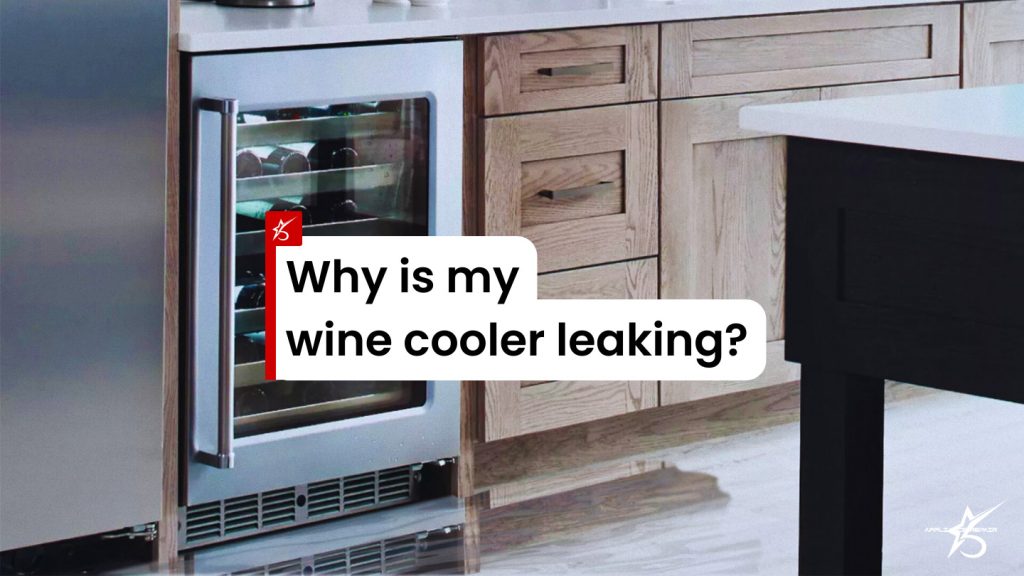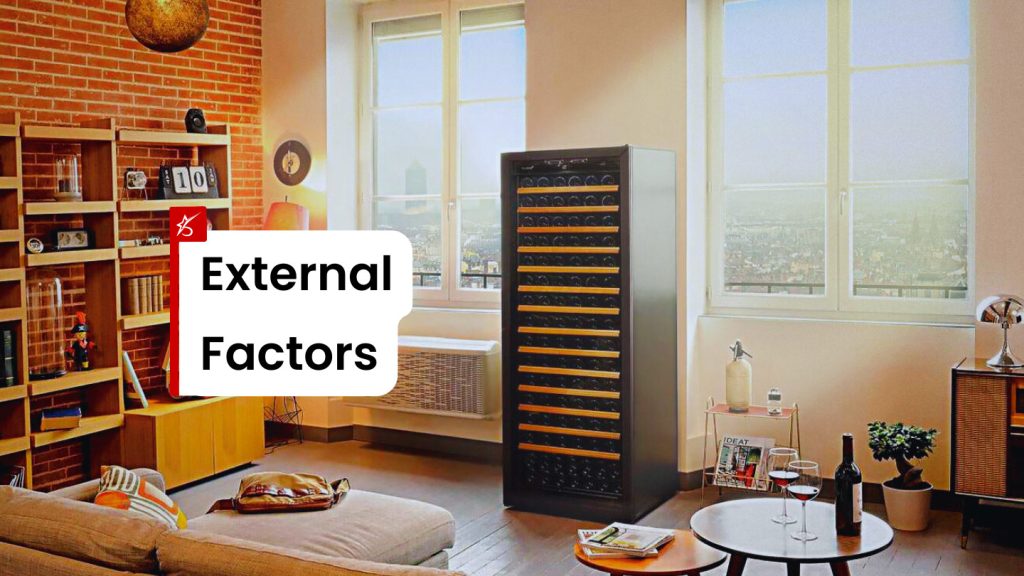Savoring the bouquet of a fine wine is a cherished delight, yet the unwelcome surprise of a wine fridge leaking water can leave any connoisseur perplexed. Amidst the elegance of your home, this issue poses an unexpected inconvenience.
In this investigation, we embark on a journey to uncover the underlying reasons behind this puzzle. From the nuances of condensation to potential seal malfunctions, join us as we demystify the factors that might derail your wine fridge’s pristine functionality, turning it into an unlikely water source.
Possible Problems of Your Wine Fridge Leaking
Discovering your wine cooler leaking water onto the floor is an unforeseen and bothersome situation. To effectively troubleshoot and resolve this issue, it’s crucial to comprehend the range of potential problems that could be causing the leakage. We will delve deeper into each issue, exploring their causes and offering practical prevention methods.
1. Condensation Buildup
Condensation buildup in wine fridges, caused by warm air meeting cold surfaces, can lead to excess moisture pooling at the bottom and leaking out.
Causes & Prevention
Causes: Condensation occurs when the surface of the wine fridge, typically cooler than the surrounding air, comes into contact with humid air. This can lead to moisture droplets forming on the exterior of the fridge, eventually pooling and leaking onto the floor.
Prevention: Ensuring proper ventilation around the wine fridge can help reduce humidity levels. Additionally, maintaining a consistent internal temperature can minimize the temperature differential between the fridge surface and the surrounding air, limiting condensation.
2. Faulty Door Seal
A damaged or malfunctioning wine fridge door seal can permit external warm air to enter, leading to condensation formation and eventual leakage.
Causes & Prevention
Causes: A compromised door seal or gasket can allow warm air from the room to infiltrate the fridge. This temperature difference can cause moisture to condense on the fridge’s exterior, resulting in leakage.
Prevention: Regularly inspect the door seal for signs of wear, cracks, or damage. Clean the seal and its surrounding area to remove any dirt or debris that might impede the proper closure of the door. A well-sealed door can significantly mitigate condensation issues.
3. Clogged Drain
If the drain in a wine fridge, designed to eliminate excess moisture, becomes clogged with debris, it can lead to water backup and leakage.
Causes & Prevention
Causes: Many wine fridges feature a drainage system designed to collect condensate and direct it away from the appliance. If this drain becomes clogged with dust, dirt, or debris, water can accumulate and overflow, leading to leaks.
Prevention: Periodically check and clean the drainage system. Gently flush warm water through the drain to remove any blockages. This maintenance task can ensure that condensate is properly drained and does not cause leaks.
4. Temperature Fluctuations
Significant fluctuations in the internal temperature of the wine fridge can lead to the formation of condensation, which might eventually lead to leakage.
Causes & Prevention
Causes: Extreme temperature fluctuations, such as sudden changes in ambient temperature or irregular cooling cycles, can cause internal components to expand and contract. This movement can potentially result in the dislodging of components, leading to leaks.
Prevention: Place the wine fridge away from direct sunlight and heat sources to maintain a consistent temperature environment. Avoid frequent adjustments to the temperature settings, as stable conditions can prevent undue stress on internal parts.
5. Overfilling
Overloading the wine fridge with bottles can obstruct the proper circulation of air, leading to temperature variations and condensation buildup.
Causes & Prevention
Causes: Stuffing the wine fridge beyond its intended capacity restricts proper airflow within the unit. Poor air circulation can lead to excess moisture accumulation, which eventually manifests as leaks.
Prevention: Adhere to the recommended storage capacity of the wine fridge. This allows adequate airflow around bottles and prevents the formation of excessive condensation.
6. Improper Installation
Incorrect installation of the wine fridge, such as placing it on an uneven surface, can cause water to collect and leak.
Causes & Prevention
Causes: Incorrect installation, such as uneven leveling or misalignment, can result in water pooling in unintended areas of the appliance.
Prevention: Follow the manufacturer’s installation instructions meticulously. Ensure that the wine fridge is placed on a level surface and aligned properly. This ensures that condensate flows to the designated drainage system.
7. Malfunctioning Cooling System
If the cooling system of the wine fridge is not functioning properly, it can cause excess condensation and leakage.
Causes & Prevention
Causes: A malfunctioning cooling system can lead to uneven cooling and excessive frost buildup. As the frost melts, it can contribute to leaks.
Prevention: Regularly inspect the cooling system for any signs of malfunction, such as irregular cooling or excessive frost. Timely maintenance and repairs can prevent leaks caused by cooling system issues.
8. Defrosting Issues
If the automatic defrosting system of the fridge is faulty, it can lead to excessive frost buildup, which might result in leaking when the frost melts.
Causes & Prevention
Causes: Neglecting to defrost the wine fridge as needed can lead to a buildup of ice within the unit. When the ice melts, it can overwhelm the drainage system and result in leakage.
Prevention: Follow the manufacturer’s recommended defrosting schedule. This prevents the accumulation of excess ice and ensures proper drainage.
9. External Factors
Environmental factors such as high humidity levels or drastic temperature changes in the surrounding area can contribute to condensation and leakage in the wine fridge.
Causes & Prevention
Causes: Environmental factors like high humidity levels and room temperature can influence the formation of condensation on the wine fridge’s surface.
Prevention: Maintain controlled humidity levels in the room where the wine fridge is located. If necessary, use a dehumidifier to reduce excess moisture in the air.
By thoroughly understanding the nuances of each potential problem and the corresponding prevention strategies, you can confidently address the issue of your wine fridge leaking. A proactive approach to maintenance and care will not only resolve the immediate concern but also contribute to the long-term functionality and reliability of your wine fridge.
Universal Preventive Measures to Prevent Leaking Wine Refrigerator
Guarding against the inconvenience and potential damage caused by a wine refrigerator leaking water requires a strategic approach to prevention. By implementing a set of universal preventive measures, you can maintain the functionality of your appliance and safeguard your valued wine collection. Let’s delve into these measures in greater detail to understand how they contribute to a leak-free and reliable wine refrigerator.
- Regular Inspection and Maintenance: Conduct regular inspections of crucial components like door seals, drainage systems, and cooling elements. Clean door gaskets, remove debris from drains, and promptly address any signs of wear or damage. By catching issues early, you can prevent potential leaks from escalating.
- Optimal Installation: Proper installation is foundational. Follow the manufacturer’s instructions meticulously, ensuring the refrigerator is placed on a level surface and has adequate ventilation. Keep the appliance away from direct sunlight and heat sources to maintain stable internal conditions and minimize the risk of leaks.
- Controlled Temperature and Humidity: Maintain consistent internal temperatures within the wine refrigerator. Fluctuations in temperature can lead to condensation formation. Additionally, control humidity levels around the unit to prevent excess moisture accumulation, reducing the chances of leaks.
- Mindful Loading: Avoid overloading the wine refrigerator, as overcrowding can impede proper airflow. Leave sufficient space between bottles to enable efficient air circulation. Proper airflow prevents excess moisture buildup and minimizes the potential for leaks.
- Timely Defrosting: Follow the manufacturer’s recommendations for defrosting intervals. Accumulated ice can obstruct drainage pathways, resulting in leaks when the ice melts. Regular defrosting prevents ice buildup and ensures proper drainage.
- Environment Management: Manage the environment in which the wine refrigerator is placed. Maintain optimal room humidity levels and temperature. High humidity and extreme temperature variations in the surrounding environment can contribute to condensation on the refrigerator’s surface.
- Professional Servicing: Schedule periodic professional servicing to ensure the cooling system is operating efficiently. A well-maintained cooling system minimizes the risk of leaks caused by malfunctions and ensures consistent cooling performance.
By integrating these comprehensive preventive measures into your maintenance routine, you not only prevent leaks but also enhance the overall longevity and performance of your wine refrigerator. A leak-free appliance safeguards your investment, preserves the quality of your wine, and provides you with the peace of mind you deserve.
Have A Technician Perform Maintenance On Your Wine Cooler
When you encounter issues like your Sub Zero wine fridge leaking water or your Frigidaire wine cooler leaking water, it’s a clear indicator that professional intervention is necessary. Entrusting your valuable appliances to capable hands is essential, and that’s where 5 Star Appliance Repair comes in. Our team of skilled technicians specializes in servicing a variety of top-notch brands, including Sub Zero, Viking, Frigidaire, Wolf, Kenmore, GE, Dacor, Electrolux, and JennAir.
Relevant articles:
[Kenmore refrigerator troubleshooting] | [Sub-zero refrigerator troubleshooting]
Our technicians are more than just repair experts – they’re licensed, certified, and extensively trained to tackle even the most complex problems. Regarding leaks in wine coolers, our professionals have the knowledge to accurately diagnose the root cause and swiftly perform the best wine cooler repair.
Rest assured, your wine cooler will receive meticulous care, ensuring it operates flawlessly and your collection remains perfectly preserved. Don’t hesitate to contact us for swift, reliable, and expert Frigidaire wne cooler repair and Sub-Zero wine cooler repair solutions that ensure your peace of mind.
FAQs on Wine Fridge Leaking
Your wine fridge may be leaking water due to condensation buildup, a faulty door seal, clogged drain, temperature fluctuations, overfilling, improper installation, or cooling system issues.
To fix a leaking wine cooler:
- Start by checking and cleaning the door seal, unclogging drains, and ensuring proper ventilation.
- Address temperature fluctuations and avoid overfilling.
- If issues persist, seek professional repair to address complex problems like malfunctioning cooling systems or damaged components.
Condensation forms in your wine cooler due to the temperature difference between the cool interior and the warmer room air. When warm air contacts the cold surface, moisture in the air condenses into water droplets. Proper ventilation and consistent temperature control can help minimize condensation buildup.
Prevent wine cooler leaks by maintaining proper ventilation, regularly checking door seals for damage, avoiding overfilling, and ensuring optimal installation. Control humidity levels, follow recommended defrosting schedules, and schedule professional maintenance to address complex issues and ensure your wine cooler’s reliability.
Leakage issues can occur across various wine cooler brands, but some may be more prone due to design or quality variations. It’s essential to research and choose a reputable brand known for quality and reliability to minimize the risk of leaking problems.











